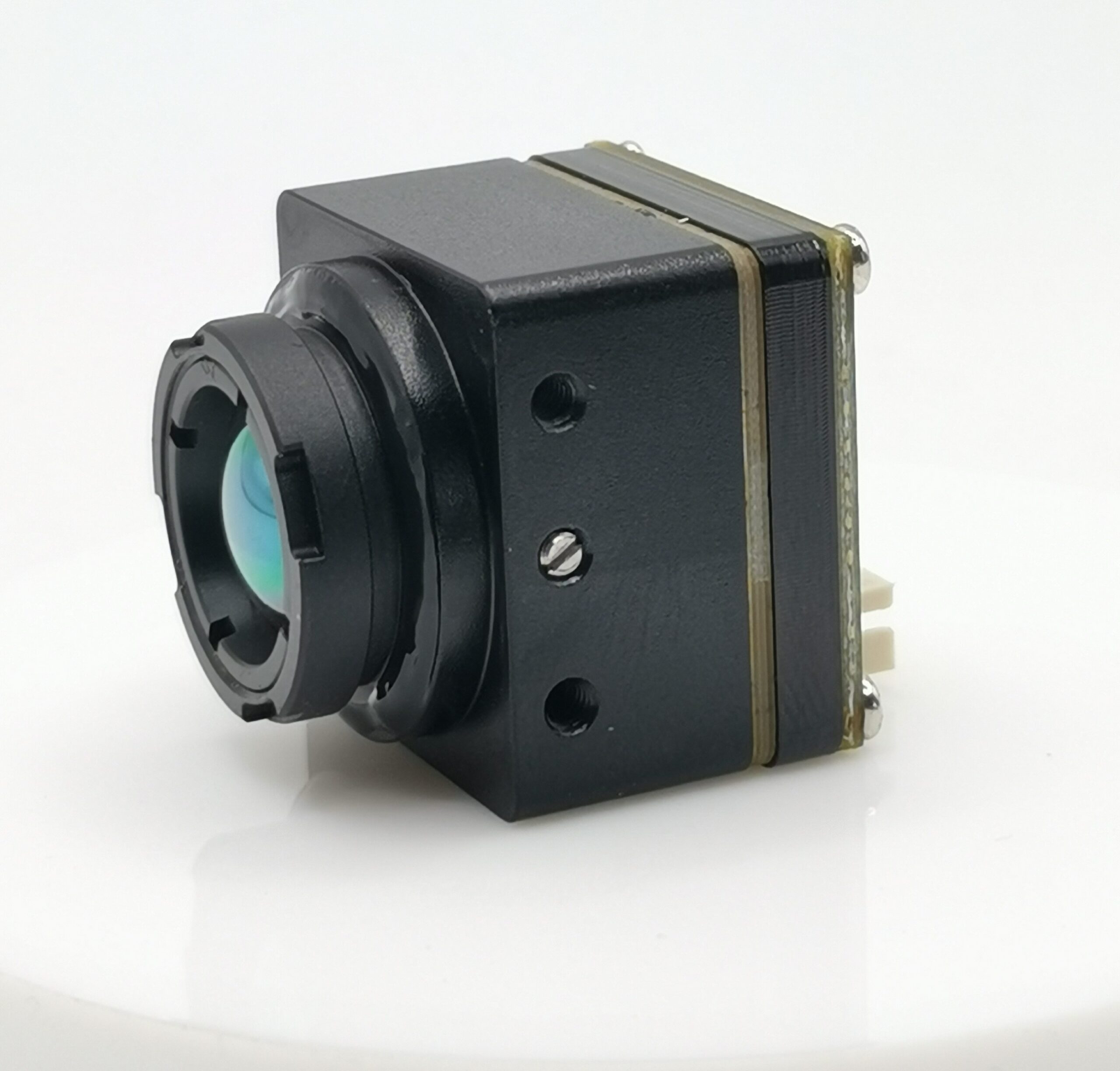
An infrared drone has special sensors that find heat from objects and living things. This drone can make pictures that show temperature changes. These pictures help people see things that normal cameras cannot. Many jobs use infrared drones, like defense, public safety, and farming. People use them for watching and checking things. More people want these drones now, especially for military and government jobs. They help people make better choices and stay safe. By finding heat patterns, an infrared drone gives users a strong tool for many real-life problems.
Key Takeaways
Infrared drones have special thermal cameras. These cameras find heat from people, animals, and things. They work even when it is dark or the weather is bad.
These drones help with many jobs. They are used for search and rescue, security, firefighting, and building checks. They show heat patterns that normal cameras cannot see.
Thermal cameras use microbolometer sensors and gimbals. These parts help make clear and steady pictures. The pictures show temperature changes.
Weather and flying conditions can change how well thermal drones work. So, people must plan flights carefully to get the best results.
Privacy and legal rules matter when using infrared drones. These rules protect people’s rights. They also help keep drone use safe and responsible.
Infrared Drone Basics
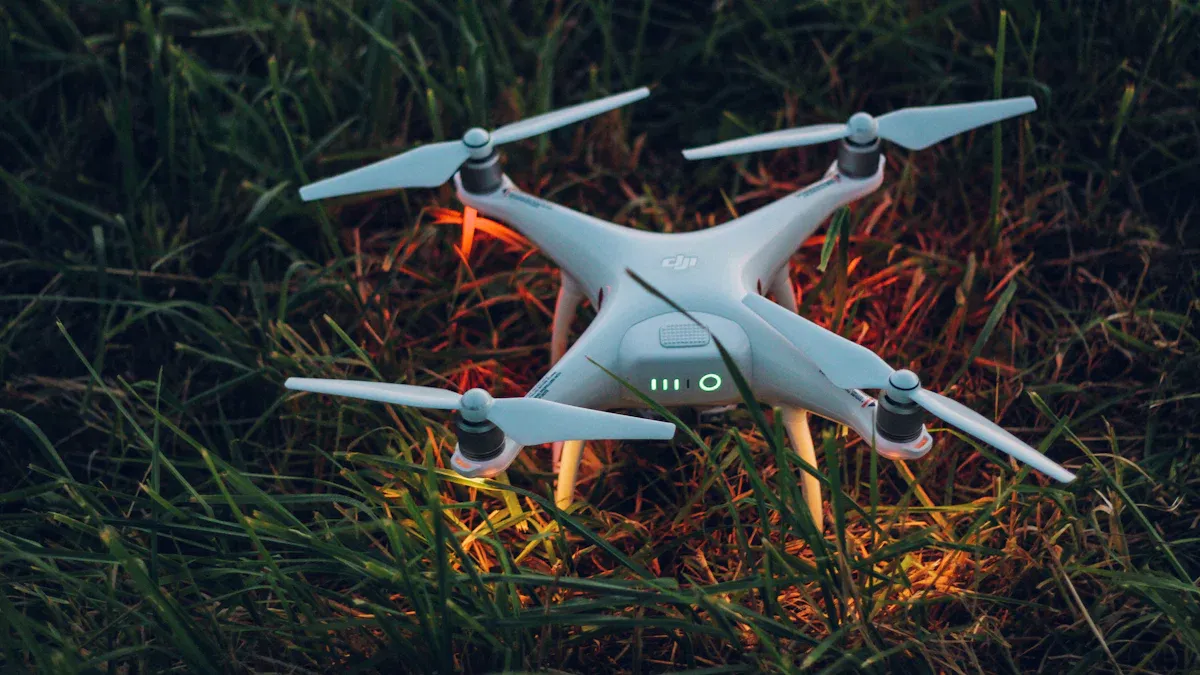
What is an Infrared Drone
An infrared drone finds heat using special technology. It makes pictures that show where things are warmer or cooler. This drone has a thermal imaging camera. The camera can see heat patterns that normal cameras miss. People use these drones for many jobs. Some examples are search and rescue, checking buildings, and police work.
Key features make an infrared drone different from a regular drone:
It uses a thermal imaging camera to spot infrared radiation from things and people.
The drone works well when it is dark, smoky, foggy, or dusty. This helps at night or in hard places.
Many thermal drones let you pick different colors to look at heat. They can also show normal and thermal pictures together.
Some drones have extra sensors, like laser rangefinders, to measure things better.
Real-time thermal data helps people make fast choices in emergencies or checks.
These drones often have special gimbals. Gimbals keep the camera steady and mix normal and thermal views.
Longer battery life lets the drone fly longer for big jobs.
Note: Infrared drones usually cost more than regular drones. Basic thermal drones start at about $3,000. Fancy ones can cost $15,000 or even more. The price is higher because of the special sensors and thermal imaging.
Drone Type | Price Range (USD) | Notes |
|---|---|---|
Entry-level Thermal Drones | Around $3,000 | Basic infrared capabilities |
Advanced Thermal Drones | $9,000 to $15,000 | Enhanced features and capabilities |
High-end Thermal Drones | $10,000 to over $30,000 | Includes thermal imaging, LIDAR, and advanced sensors |
Standard Professional Drones | $2,000 to $10,000 | Similar flight specs but without thermal imaging |
Consumer Drones | $300 to $1,500 | Basic drones without advanced sensors |
How Infrared Drones Detect Heat
Thermal drones work by using infrared radiation. Everything gives off heat as infrared energy, even if it feels cold. The thermal imaging camera on the drone can see this invisible heat. It does not need light, so it works in the dark or through smoke and fog.
The camera uses special lenses to let infrared waves reach the sensor. The sensor, called a microbolometer, checks for tiny changes when it gets warm from the heat. It measures changes in resistance, voltage, or current. The camera turns these changes into a thermal image. The picture uses colors or shades to show hot and cold spots.
Thermal imaging works for many temperatures. Some drones can find heat from -40°C (-40°F) up to 1022°F. The table below shows the temperature ranges for some popular thermal drones:
Drone Model / Sensor | Temperature Detection Range (°C) | Temperature Detection Range (°F) |
|---|---|---|
DJI Zenmuse XT2 | -40 to N/A | -40 to 1022 |
DJI Zenmuse H20N / H20T | N/A | -4 to 122 |
Teledyne FLIR Vue TZ20-R | N/A | -4 to 113 |
Autel EVO Max 4T | N/A | -4 to 140 |
Deepthink S3 | -20 to 150 | N/A |
DJI Mavic 2 Enterprise Adv. | -20 to 150 | N/A |
Autel EVO II Dual 640T | -20 to 150 / 0 to 550 | N/A |
Parrot Anafi Thermal | -10 to 140 | N/A |
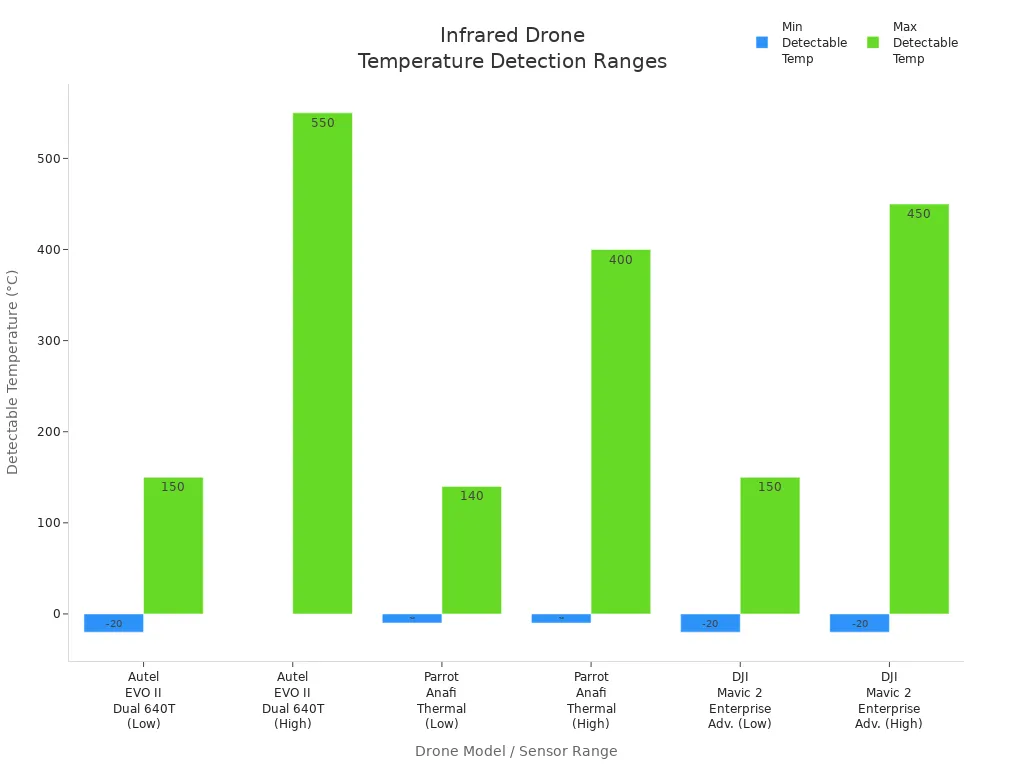
Thermal drones can spot heat from people, animals, machines, and buildings. This makes them useful for many jobs. They help find missing people, check for electrical problems, or see animals at night. Thermal drone technology keeps getting better. These tools are now even more helpful and easier to use.
How Infrared Drones Work
Thermal Camera Technology
Thermal drones have special cameras that can see heat. These cameras find infrared radiation from things and living creatures. Most thermal drones use VOx microbolometer sensors. These sensors work in the 8 to 14 micrometer range. This helps the drone find heat in many places.
Thermal camera resolution is very important. High-resolution cameras, like 640 x 512 pixels, show more details. They help people see small temperature changes and clear pictures. Lower resolution cameras, like 320 x 256 pixels, show less detail. They might miss important things. Many top drones use high-resolution cameras, such as FLIR Vue Pro R, DJI Zenmuse H20T, and Workswell WIRIS Pro.
High-resolution cameras cost more, but they give better results for checks and safety.
Thermal camera systems in drones often have digital zoom, more than one lens, and can handle bad weather. These features help the drone work in rain, dust, or fog. The table below lists some popular drones and their thermal sensors:
Drone Model | Thermal Sensor Type | Infrared Resolution | Frame Rate | Infrared Wavelength (µm) | Additional Features |
|---|---|---|---|---|---|
DJI Zenmuse XT2 | FLIR Tau 2 (Uncooled VOx) | 640 x 512 or 336×256 | 9 or 30Hz | 8 – 14 | Gimbal stabilization, IP44 weather resistance |
DJI Zenmuse H20N | Uncooled VOx Microbolometer | 640 x 512 | 30Hz | 8 – 14 | Wide & zoom lenses, IP44 |
DJI Zenmuse H20T | Uncooled VOx Microbolometer | 640 x 512 | 30Hz | 8 – 14 | Wide & zoom RGB cameras, IP44 |
Teledyne FLIR Vue TZ20-R | FLIR Boson 640×512 (Uncooled VOx) | 640 x 512 | 25-30Hz | 8 – 14 | Dual lenses (wide & tight), IP44 |
Autel EVO Max 4T | Uncooled VOx Microbolometer | 640 x 512 | 30Hz | 8 – 14 | 16x digital zoom, 4-in-1 imaging system |
DJI Matrice 4T | Uncooled vanadium oxide (VOx) | 640 x 512 | 30Hz | 8 – 14 | Gimbal stabilization |
DJI Mavic 3T | Uncooled VOx Microbolometer | 640 x 512 | 30Hz | 8 – 14 | Compact design |
Teledyne FLIR SIRAS | Uncooled VOx Microbolometer | 640 x 512 | 60Hz | 8 – 14 | High frame rate, rugged design |
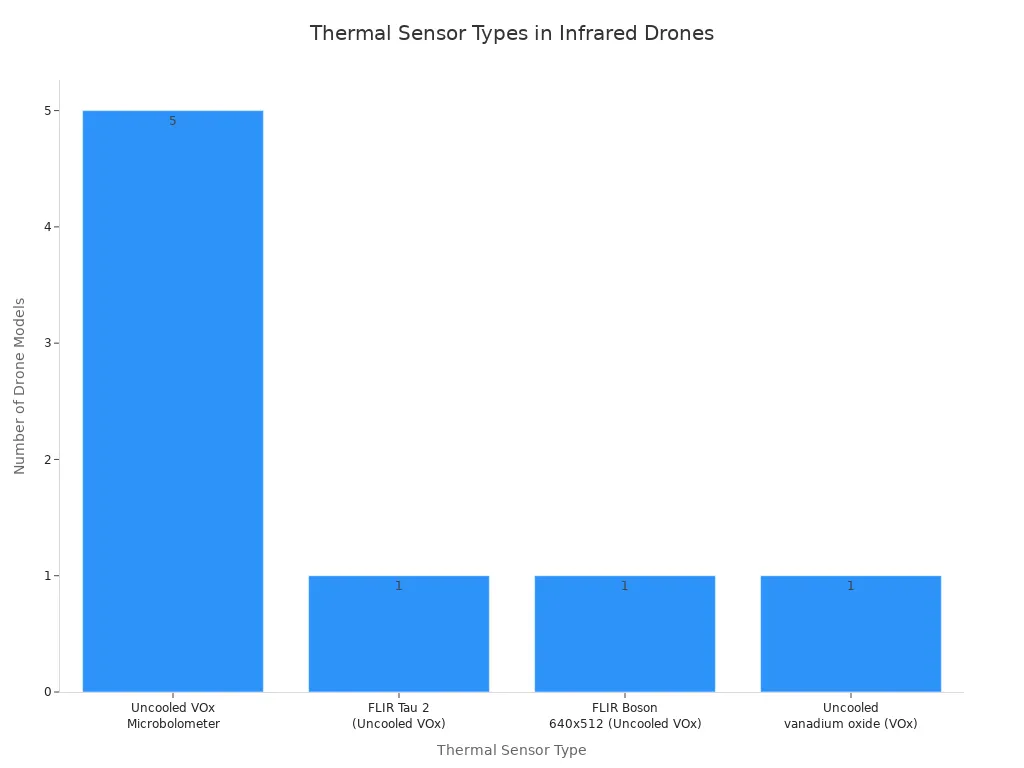
Thermal cameras let the drone make pictures that show hot and cold spots. These pictures help people find problems in buildings, spot people or animals, and check equipment. Thermal cameras cannot see through walls or glass. They only show heat on surfaces they can “see” directly.
Microbolometer Sensors
Microbolometer sensors are the main part of most drone thermal cameras. These sensors pick up infrared radiation from things. The amount of radiation changes with temperature. The sensor turns this into a thermal image.
Most thermal drones use uncooled VOx microbolometer sensors. These sensors do not need special cooling. This makes the drone lighter and easier to use. The sensor works at room temperature and lasts a long time. It also uses less power, so the drone can fly longer.
Microbolometer sensors have many good points:
They are small and light, which is good for drones.
They use less power, so the drone can stay in the air longer.
They last longer and cost less than cooled sensors.
Thermal imaging with microbolometer sensors helps the drone find heat in darkness, smoke, or bad weather. This makes thermal drones useful for many jobs, like search and rescue or checking power lines.
Image Stabilization with Gimbals
Thermal drones need clear pictures to be helpful. Gimbals keep the thermal camera steady while the drone moves. A gimbal is a special mount that holds the camera and moves to stop shakes and tilts.
Most new drones use 3-axis gimbals. These gimbals control yaw, pitch, and roll. Some bigger drones use 4-axis gimbals, which also control up and down motion. The gimbal uses motors and sensors to sense movement and quickly move the camera. This keeps the camera pointed right and reduces blur.
Stabilized Axes | Description | |
|---|---|---|
2-axis | Pitch and Roll | Gyro-stabilized gimbals stabilizing pitch and roll only. |
3-axis | Yaw, Pitch, and Roll | Typical modern standard providing full orientation control. |
4-axis | Yaw, Pitch, Roll, plus vertical (up/down) motion | Adds an additional vertical motion axis for enhanced stabilization. |
Gimbals are important for thermal imaging because they help the drone take sharp, clear pictures even in wind or when turning fast. This is very important for jobs like surveillance, inspections, and search and rescue. Gimbals also let the drone use both regular and thermal cameras at the same time, giving users more information.
Tip: A steady thermal camera gives better pictures, making it easier to see small temperature changes or moving things.
Thermal camera technology, microbolometer sensors, and gimbals all work together. They help thermal drones give clear, accurate thermal images for many uses.
Infrared Drone Components
Drone Platform
A strong drone platform holds all the needed parts. The frame, motors, propellers, and battery give shape and power. The flight controller helps the drone move smoothly and follow commands. The GPS module tells the drone where it is and helps with mapping. All these parts work together to carry the thermal camera and sensors safely.
The drone’s size and weight decide which thermal cameras it can use. Small drones need light and small thermal imaging systems. These drones use uncooled thermal sensors because they are lighter and use less power. The platform’s design also changes how long the drone can fly and how far it can go. Good lenses and smart optical designs help the drone get clear pictures, even if it is small or light.
Tip: Picking the right drone platform helps users get the best results from their thermal imaging equipment.
Infrared Camera
The infrared camera is the main tool for taking heat pictures. When choosing a thermal camera, people look at important features:
Temperature range
Field of view
Focus options
Spectral range (midwave or longwave infrared)
Noise Equivalent Temperature Difference (NETD)
Radiometric capability
Thermal cameras with high resolution and wide temperature ranges make better images. Some cameras, like the Zenmuse XT2, can do radiometric imaging, so each pixel shows temperature data. This helps with detailed checks and reports. The camera must also fit the drone and the job, like finding gas leaks or checking buildings.
Sensors and Software
Thermal drones use more than just cameras. They have extra sensors, like GPS, barometers, and gyroscopes, to help with flying and collecting data. Some drones use special thermal sensors, like IR LEDs and photodiodes, for harder jobs.
Software is important for handling data from thermal cameras. Programs like Thermogram and FLIR Thermal Studio Suite help people process, measure, and report thermal images. Cloud tools, such as FLIR Ignite, let users store and share images easily. Some software uses AI to find problems and make reports automatically. These tools make it easier to use data from thermal imaging for inspections and safety checks.
Software Name | Description | Key Features |
|---|---|---|
Thermogram | Processes infrared images from DJI drones | 3D viewer, palette controls, object detection |
FLIR Thermal Studio Suite | Analysis and reporting for thermal images | Batch processing, anomaly measurement, reporting |
FLIR Ignite | Cloud storage and sharing for thermal data | Secure upload, in-field editing, report generation |
Thermal Imaging Process
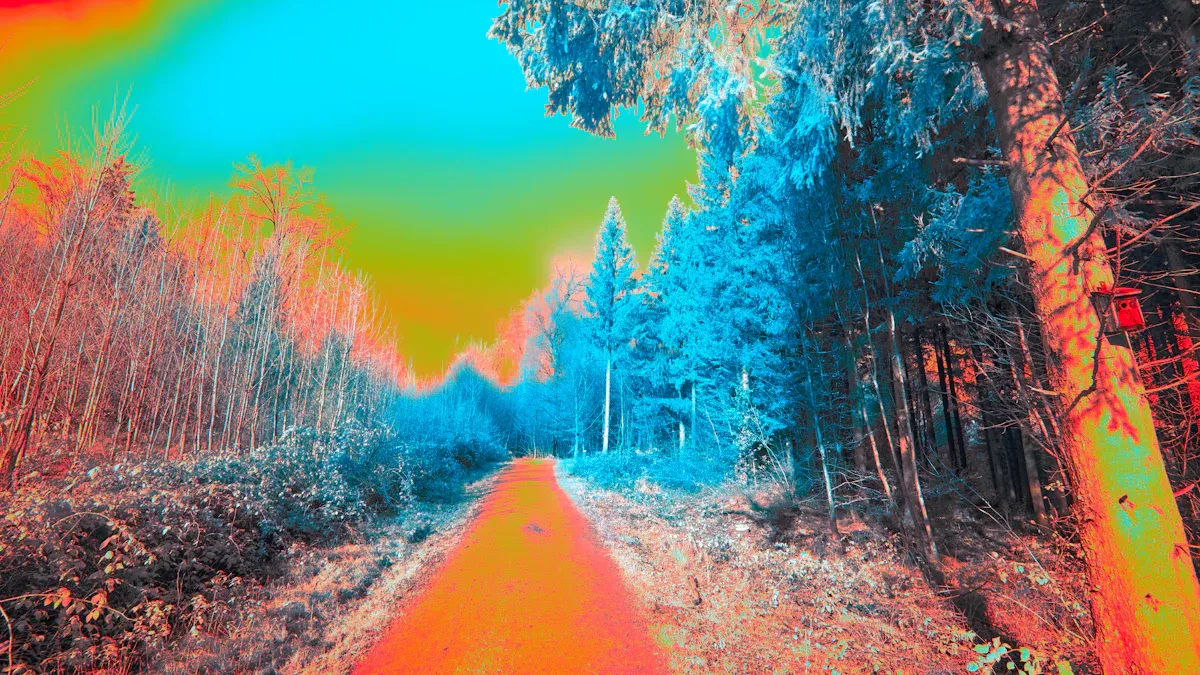
Capturing Infrared Radiation
Infrared drones have cameras that find heat from things and living creatures. These cameras sense invisible infrared radiation in a certain range. Every object, like people, animals, or machines, gives off heat. The camera can pick up this heat. The drone helps the camera move and stay steady. This lets it scan big or hard-to-reach places.
The thermal camera gets temperature data for each pixel it sees. The flight system sends this data live, so users see heat patterns right away. Operators can change color palettes to make temperature changes easier to spot. The drone saves these pictures and videos or uploads them for later. This helps users find problems like missing insulation, hot parts, or lost people from far away.
Note: Things like weather and what objects are made of can change how much heat the camera sees. Operators need to think about these things for good thermal images.
Creating Thermal Images
After the camera gets raw infrared data, the system turns it into a picture called thermal imagery. Each pixel in the picture shows a temperature. The software gives colors to different temperatures, so hot and cold spots are easy to see. Hot areas are often red or white. Cold spots are blue or purple.
The process usually goes like this:
The drone’s thermal sensor records heat and saves it in a special file.
The system might use formats like radiometric JPG or Geotiff to keep temperature and location info.
Software works with these files, sometimes joining images, to make a clear thermal picture.
Users look at the final image to find temperature changes, spot problems, or help with checks.
Thermal imaging lets drones show hidden problems in buildings, electrical systems, or nature. This technology gives users a strong tool for safety, repairs, and research.
Drone with Thermal Camera Applications
Security and Surveillance
A drone with a thermal camera helps keep places safe. Police use these drones to follow suspects and watch crime scenes. They also use them to check big events. Businesses use drones to watch fences and spot people who should not be there. Border patrol teams use drones to watch the border from the sky. They can find people crossing where they should not. Emergency teams use drones during disasters to watch crowds and help keep everyone safe. These uses help teams act faster and lower danger.
Drones with thermal cameras can find heat even in the dark or through smoke. This makes them good for watching places all day and night.
Search and Rescue
Search and rescue teams use drones with thermal cameras to find people fast. These drones can see heat from missing people, even at night or in fog. Teams can send out drones quickly and search big areas. This helps them find people faster. Drones also keep rescuers safe by showing live views of risky places. Drones cost less and work in any weather, unlike old ways of searching.
Aspect | Infrared (Thermal) Drones | Traditional Methods |
|---|---|---|
Deployment Speed | Minutes | Hours |
Area Coverage | Large | Limited |
Time to Locate | Nearly 1 hour | |
Risk to Personnel | Minimal | Higher |
Cost | Lower | Higher |
Fire and Disaster Response
A drone with a thermal camera helps firefighters find fires and stay safe. Firefighters use drones to see through smoke and watch how fires move. This keeps them away from danger and helps them find small fires fast. Live thermal images show where the fire is hottest, so crews know where to go. In one case, a fire team used a drone to map a fire in a business. This helped them stop the fire faster and save more property. Drones also help find people and dangers after disasters, keeping helpers safe.
Building and Environmental Inspections
Inspectors use drones with thermal cameras to find heat loss and leaks in buildings. The drone flies over roofs and hard spots to reach. It takes thermal pictures that show hidden problems. Finding heat loss or leaks early saves money and energy. In nature work, drones watch temperature changes in forests and wetlands. This helps with climate studies and finding fires. High-resolution thermal cameras make pictures clearer, but weather can make images harder to read.
Tip: Drones help make checks safer and faster by going to places that are hard or risky for people.
Limitations of Thermal Drones
Technical Challenges
Thermal drones have some problems that make them less accurate and reliable.
The spinning propellers move the air around the drone. This moving air can mess up the thermal sensor. Sometimes, this makes the temperature reading wrong by more than 5 °C.
When the drone is flying, the thermal camera might show different temperatures than when it is still. This makes it hard to trust the data while the drone is moving.
Most infrared cameras use microbolometer sensors. These sensors work best at room temperature. But changes in the weather can make their readings less steady.
Putting a shield around the camera can help block the moving air. Tests show that with a shield, the temperature error can be less than 1 °C.
Thermal drones still follow the same science as old infrared cameras. Things like wind and temperature during flight are very important for how well the drone works.
Weather and light also change how well a thermal drone finds heat. Things like air temperature, sunlight, wind, and the ground below all matter. For example, flying on cloudy days or at dawn helps the drone find heat about 70% of the time. But flying in bright sun only works about 40% of the time. Bad weather, like heavy rain or strong wind, makes drones work worse.
Environmental Factor | Effect on Accuracy | Notes |
|---|---|---|
Air Temperature | Higher temps improve detection | >3°C = >70% detection |
Sky Conditions | Cloudy/dawn better than sunny | Cloudy/dawn ≈ 70%, Sunny ≈ 40% |
Weather | Extreme weather reduces performance | High winds, rain, fog hinder drones |
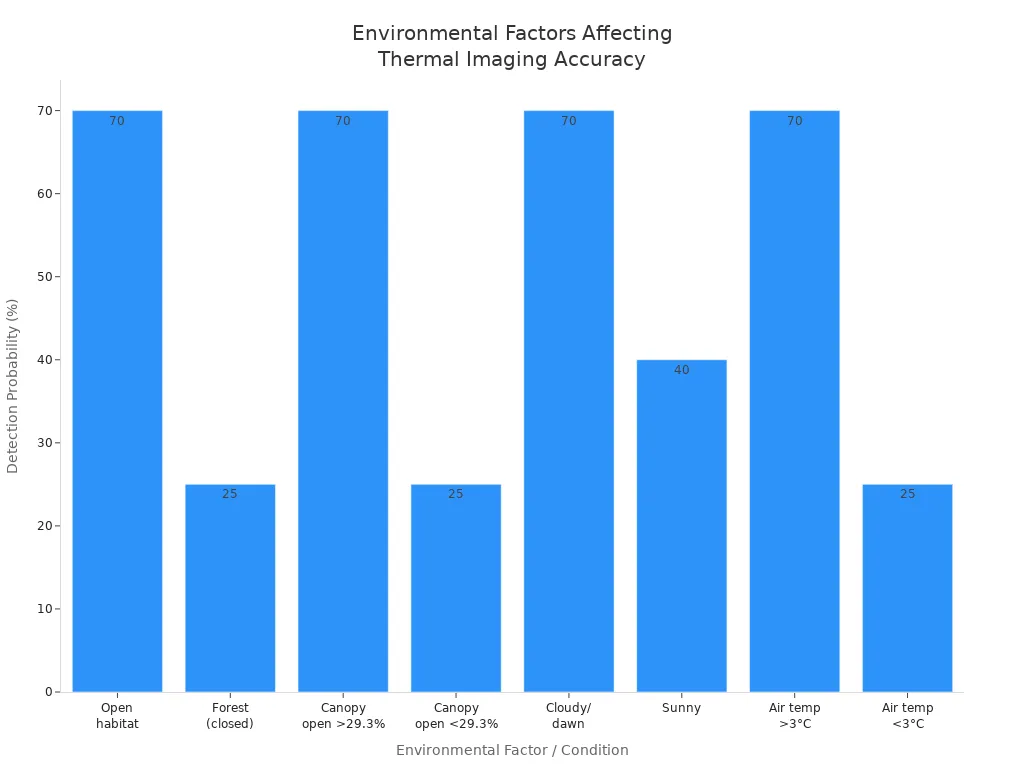
Legal and Ethical Considerations
Thermal drones also bring up legal and ethical issues.
People worry about privacy because drones can see things that are hidden from the ground. The Supreme Court says police may need a warrant to use thermal imaging on private property.
Drones might record people by mistake. This could lead to sharing private or secret information.
Groups like the ACLU want strong rules to keep people’s privacy safe when drones are used.
Drone pilots should use tools like geofencing to keep drones away from private places. They can also use video redaction to hide faces or personal details.
Good habits include building privacy into the drone’s design and talking to the community about drone use.
Using encryption and removing personal details from data helps keep information safe.
In public places, drones may not need permission to fly. But flying over private property is a bigger privacy problem.
Drone pilots must respect privacy and follow the law. Using clear rules and safety tools helps protect people’s rights and lets drones help the community.
Infrared drones help people check, watch, and protect places quickly and safely. They also save money. Experts say these drones have big advantages, like:
People can make choices right away and get important data.
Many fields, like farming, energy, and public safety, use these drones for better work. As technology gets better, more people can learn how to use them with help from IRINFO.org and the Infrared Training Center. Infrared drones will keep changing how people inspect things and respond to emergencies.
FAQ
How far can an infrared drone see at night?
Most infrared drones can find heat from far away. They usually spot heat up to a few hundred feet. The distance depends on the camera’s lens and resolution. Some expensive drones can see people or animals over 1,000 feet away in open places.
Can an infrared drone see through walls or glass?
Infrared drones cannot look through walls or glass. The thermal camera only shows heat on surfaces it can see. Glass reflects infrared radiation, so the camera cannot show what is behind it.
Are infrared drones legal to use?
Infrared drones are allowed in many places, but there are rules. People must follow local laws and respect privacy. Sometimes, you need a permit to fly or record with a drone.
What industries use infrared drones the most?
Many jobs use infrared drones. Firefighters, police, farmers, and building inspectors use them a lot. These drones help with rescue, safety checks, and finding problems in buildings or machines.
Do weather conditions affect thermal drone images?
Yes, weather can change how well thermal drones work. Rain, fog, wind, and bright sun can make images worse. Cloudy days or mornings usually give the best pictures.
See Also
Using Thermal Cameras Effectively For Search And Rescue Missions
Vanadium Oxide Thermal Cameras Enhancing Rescue Operations Today
The Importance Of Thermal Imaging Cameras In The Year 2025
AI Wireless CarPlay Boxes Compatible With All Vehicle Models
